The travel industry is one of the largest and most lucrative sectors globally, valued in the trillions and continually expanding. When you merge this with mobile app technology, you tap into one of the most profitable niches—travel apps.
The travel and tourism sector was the second-fastest-growing app category on the Apple App Store, boasting a 40% growth rate. Furthermore, a survey revealed that 17% of Americans subscribe to at least one travel app to assist in their travel planning.
Popular travel apps, including those for flight bookings, hotel reservations, and travel guides, attract significant attention.
The development of travel apps is becoming increasingly popular, with numerous travel agencies, hotels, and related businesses eager to develop their apps.
If you’re interested in learning more about how to build a travel app, this blog is for you. We’ll cover everything you need to know about this burgeoning field. So, let’s dive in and explore the essentials.
What is a Travel App & Its Types?
Travel apps offer a comprehensive range of features to assist users from the moment they start planning their trip until they return home.
They typically provide different functions that include booking flights, hotels, rental cars, and much more directly through their smartphones.
Additionally, travel apps often include tools for creating and managing itineraries, which help users organize their travel plans and keep track of important details like flight schedules and accommodation reservations.
By consolidating these diverse functionalities into one platform, travel apps make planning and managing travel more convenient and efficient, enhancing the travel experience.
There are several types of travel apps currently present in the market catering to different needs and preferences.
Let’s examine the various travel apps and discover the options available:
![Different_Types_of_Travel_Apps[1]](https://www.nimbleappgenie.com/blogs/wp-content/uploads/2024/08/Different_Types_of_Travel_Apps1.webp)
1. Booking Apps
Such booking apps enable the reservation of travel services like flights, hotels, and car rentals.
They compare hundreds of different providers to bring you the best prices for flights in real-time so that you have all the latest information at your fingertips before booking a trip to any country from any city in the world.
From real-time availability and instant booking confirmations to secure payment options; these apps streamline the next step in your journey.
With these apps, the user can find all of their reservation needs in one spot — planning and booking travel is made easier this way, and also you get what suits your budget with maximum comfort.
2. Navigation Apps
Navigation apps offer real-time directions and maps for different means of transport, such as cars or bicycles.
Turn-by-turn directions, traffic updates, and route optimization are some of its features. Google Maps and Waze are some well-known examples.
This helps users to get to their destination promptly, avoid traffic jams, and easily explore new locations with confidence, hence providing the smoothest travel experience.
3. Local Experience Apps
Experience app strategies focus more on what travelers can do when they arrive.
They deliver relevant recommendations for events, dining, and activities based on personal preferences along with the user’s current location.
Examples include apps like TripAdvisor and Yelp. These apps provide user feedback and ratings, and curated lists to optimize a traveler’s time with the best local culture and attractions.
4. Language Translation Apps
Language translation apps help travelers by translating spoken or written text into a foreign language. These are necessary for traveling to a foreign country, ordering food, or locating somebody.
For text translation, voice translation and offline access Google Translate or iTranslate are two popular apps.
With the assistance of these tools, travelers will able to deliver information successfully, therefore improving their experience and without a hitch places in not-so-comfortable dialects.
5. Expense Management Apps
Expense management apps allow travelers to keep a check on their spending and also control their budgets in movement.
A corporate travel provider that offers these features in their app can manage company travel policies and keep track of each expense associated with a business trip. This saves time and allows greater insights into spending data, enabling businesses to optimize travel budgets, identify cost-saving opportunities, and ensure compliance with internal guidelines across all levels of the organization.
Expense categorization, currency conversion, and receipt capture. Like Expensify and Trail Wallet.
Whether you are going for personal trips or business travel, these apps are designed in such a way that recording expenses and whatnot becomes hassle-free.
6. Travel Itinerary Apps
Travel itinerary apps help users store all their trip details — flights, accommodations, activities, etc., in one place.
Features like syncing itineraries, real-time updates, and reminders are part of these apps!
In addition, apps like TripIt and Google Trips provide users with a way to collect detailed travel plans, keeping them organized during their travels.
These apps compile your travel details, reducing some of the stress and making sure you never have to fumble for any important information.
7. Weather Apps
For most, weather apps offer updated forecasts and conditions for locations all over the globe. Some of its features include forecasts by the hour and day, weather alerts, and climate.
The apps enable travelers to plan their activities and pack accordingly in anticipation of what the weather will be like, thus better preparing them for different scenarios ensuring a more comfortable traveling experience from all seasons.
8. Safety and Emergency Apps
Resources for tools, as well as information collection, reveal what helps to provide travelers stay safe.
This information could include emergency contacts, safety advice, and real-time alerts of natural disasters or immediate security concerns.
Smart Traveler is an app that gives US travelers access to life-saving information and services if they are going to an unstable region and want to know what risks may lay ahead.
Why You Should Build A Travel App?
So, why should you create a Travel App? This is a question that a lot of people ask.
In this section, we will be discussing the benefits of creating a travel app. Let’s get to know it:
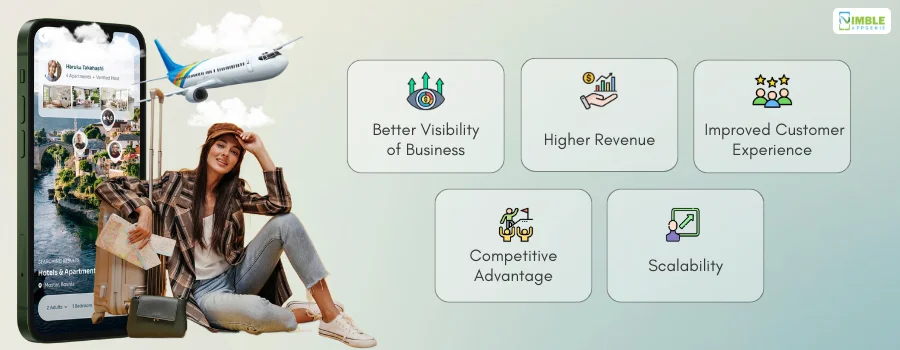
♦ Better Visibility of Business
One of the biggest reasons to make a travel app is that it gives your business better visibility. Therefore, this small investment will produce higher revenue.
Timely, you can send them push notifications, in-app messages, and personalized offers to reach specific segments of your audience. This ensures that your marketing efforts are more effective and relevant.
♦ Higher Revenue
The travel industry is booming right now. Making an app in this niche might help you generate huge revenue using the right monetization strategies.
Post-pandemic, people are more excited to explore new destinations, reconnect with loved ones, and experience different cultures. This surge in travel demands a prime opportunity for developers to create innovative and profitable travel apps.
♦ Improved Customer Experience
If you create a travel app as per user demand and preferences, you can help them find what they are looking for.
Users can access your services anytime, anywhere, with just a few taps on their smartphones. By collecting user data, you can offer personalized recommendations, tailored itineraries, and relevant offers.
♦ Competitive Advantage
The travel industry is highly competitive.
To stand out and attract customers, it’s essential to offer a unique and valuable experience. By offering unique features that your competitors may not have, you can attract customers who are looking for something special.
This may include extra features such as personalized itineraries, augmented reality experiences, or exclusive partnerships with local businesses.
♦ Scalability
A travel app can be easily scaled to accommodate a growing customer base, allowing you to expand your business without additional costs or resources.
Once your user base grows, you can simply scale up your infrastructure to handle the additional traffic and data.
This scalability allows you to expand your business into new markets, offer additional features, and accommodate more users without the need for significant investments in physical resources or personnel.
To understand this, let’s get to know about the features you should integrate into your app.
Features That You Should Integrate Into Your Travel App
Features are one of the most important and core parts of any app development project.
So, what are the features to include while building your travel and tourism app? Some essential features that we recommend are, as mentioned below:
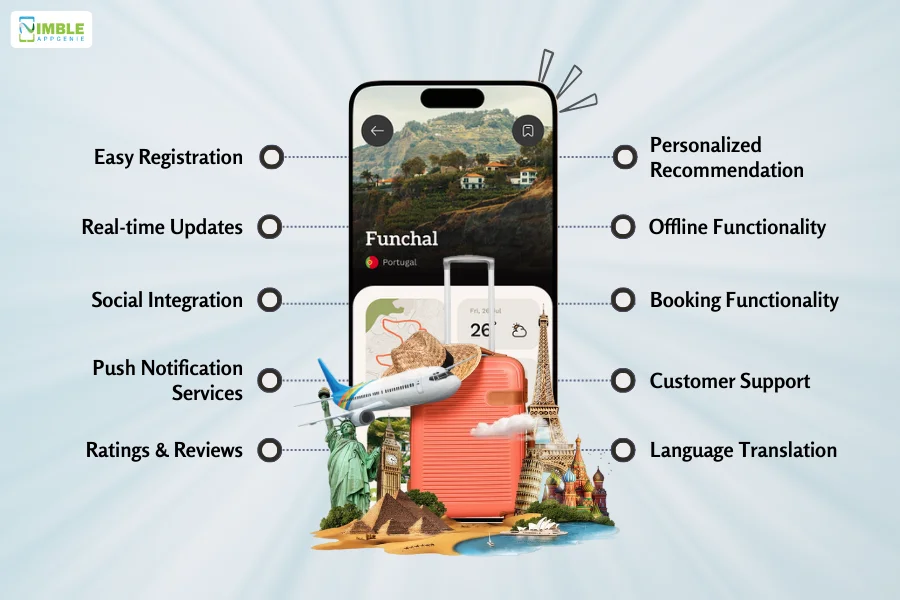
1. Easy Registration
One of the most common features to integrate into your travel booking app is easy & quick registration.
A travel app should have a simple and intuitive registration process to minimize user friction. This can be achieved by offering options like social media login (Facebook, Google) or quick email sign-up.
Plus, a streamlined registration process encourages users to create accounts and start exploring the app’s features.
2. Personalized Recommendation
A travel app should leverage AI and machine learning to offer personalized recommendations based on user preferences, past searches, and booking history.
This feature enhances the user experience and increases engagement. Personalized recommendations demonstrate that you understand your users’ needs and preferences, making your app valuable and relevant to them.
3. Real-Time Updates
You can provide real-time updates on flight statuses, weather conditions, and local events. This keeps the user informed and helps them plan their trips efficiently.
For example, if a flight is delayed or canceled, users can receive instant notifications and make adjustments to their itinerary.
Similarly, real-time weather updates can help travelers pack appropriately and avoid unexpected weather-related disruptions.
4. Offline Functionality
One of the key benefits of a travel app is being able to function offline.
This means that even when users are in areas with limited or no internet connectivity, they can still access their journeys, maps, and more information.
It’s particularly valuable for those travelers exploring remote destinations where internet access may be unreliable or unavailable. Don’t overlook it when building a travel app.
5. Social Integration
You can allow users to connect with friends and family through social media integration.
This enables them to share their travel experiences, get recommendations, and stay connected while on the go. This will help your brand to become known and reach more people.
6. Booking Functionality
Booking Functionality is a popular feature to include while developing a travel app, and taking inspiration from it, you should ensure booking functionality in your app.
By integrating different functions into a single platform, you eliminate the need for users to navigate between multiple websites or apps, creating a more cohesive and efficient travel planning process.
For example, you can offer them bookings for flights, hotels, and activities directly within your app. If you are developing a corporate travel app, make sure you do not forget to include booking functionalities like multi-user booking options and credit card authorization to ensure secure payments and streamlined approval workflows.
7. Customer Support
Customer Support is important in today’s world. To make a Travel app that’s successful in the market, you need to assist during times of need.
Users expect prompt responses to their inquiries. Aim for quick turnaround times to keep customers satisfied. Consequently, you should provide multiple channels for users to contact support, such as in-app chat, email, and phone.
This allows users to choose the method that best suits their needs.
8. Ratings & Reviews
One amazing feature that we commonly see in the Airbnb-like app development is Reviews and Ratings.
It has become a necessity through which other users will get an idea about the experience.
Moreover, positive reviews can boost your app’s visibility in App stores and attract new users, while negative reviews can provide valuable insights for addressing issues and improving your app’s overall quality.
9. Language Translation
Language translation is a valuable feature for developing travel apps, especially for those targeting international travelers.
By providing language translation capabilities, you can help users communicate with locals, understand foreign menus or signs, and navigate unfamiliar environments more easily.
This feature can enhance the overall user experience and make travel more accessible for people from diverse backgrounds.
Advanced Features for a Travel Booking App
As soon as you decide to build a mobile travel app, advanced features become important. As it can help you to enhance the user experience and set your app apart.
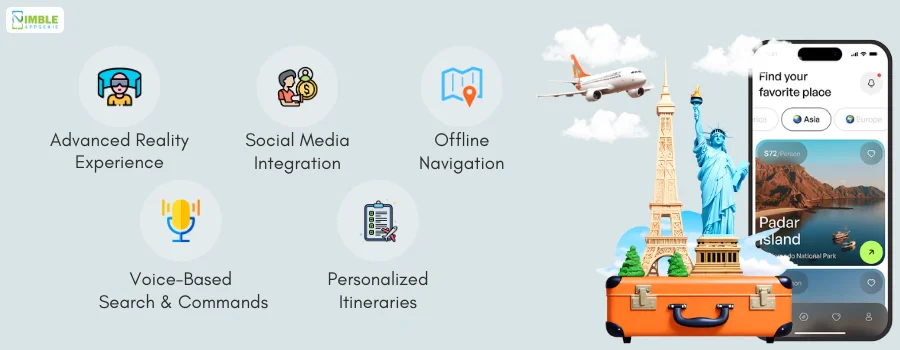
1. Advanced Reality Experience
With many industries leveraging the power of AR development, you can also utilize AR technology to provide an immersive experience for users.
For example, you could allow users to virtually explore destinations or even see landmarks overlaid on real-world views through their smartphone camera.
2. Social Media Integration
Foster a sense of community by integrating social networking features. You can allow users to connect with other travelers, share their experiences, and join different travel groups.
This can enhance the social aspect of travel and provide valuable recommendations from like-minded individuals.
3. Offline Navigation
This could be a game changer for your travel booking app.
Even in areas with limited or no internet connectivity, users should be able to access offline maps and navigation features. This is basically important for travelers exploring remote destinations or experiencing network disruptions. It’s a must-have in your travel booking app to make it more user-friendly.
4. Voice-Based Search and Commands
Implement voice recognition technology to allow users to search for destinations, ask questions, or make bookings using their voice.
This hands-free feature can be convenient for travelers on the go.
5. Personalized Itineraries
Make sure to go beyond basic recommendations and create personalized itineraries based on users’ interests, preferences, and travel styles.
Incorporate AI and machine learning to suggest unique activities and hidden gems that align with individual preferences.
Top Travel Apps to Get Inspired From
Before you proceed to make a travel app, it’s essential to know the available competitors in the market.
Here is a list of top travel apps that will encourage you in this process.
1] Tripit
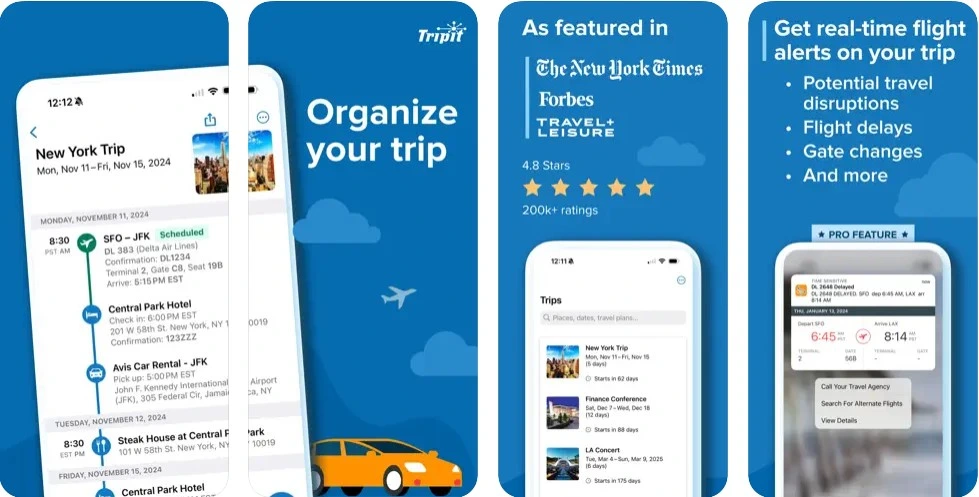
TripIt is the world’s largest travel app with the highest ratings. Here people can book a flight, rental car, hotel, and other travel plans.
The app helps users organize their trips by providing them with information via email. It assists in pulling out important information from the available hotels, restaurants, and places, that the user is interested in visiting.
2] Hopper
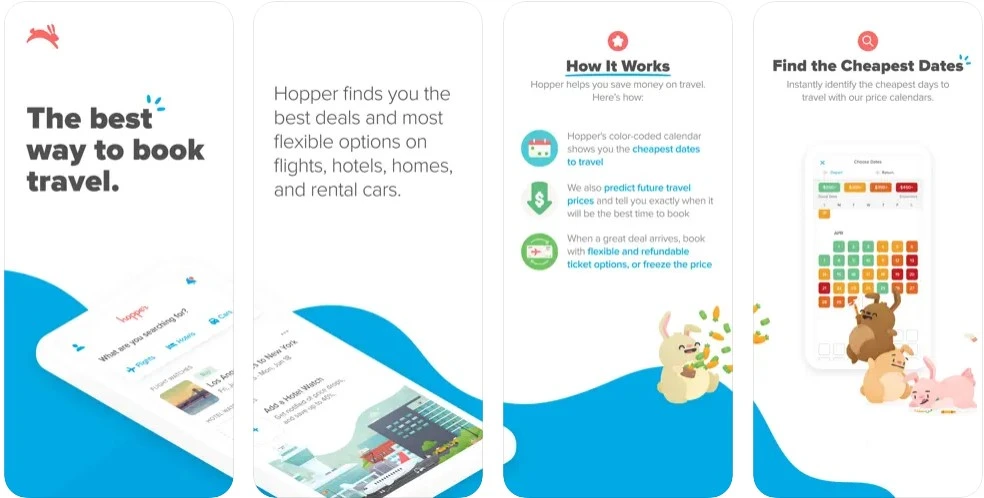
Hopper understands the value of money and knows the type of expenses people usually incur while traveling. You can develop an app like Hopper after analyzing its amazing features.
Thus, the app focuses on spending less and traveling better. It has ranked as the top app in over 70 countries, assisting people to travel the world.
3] Tripadvisor
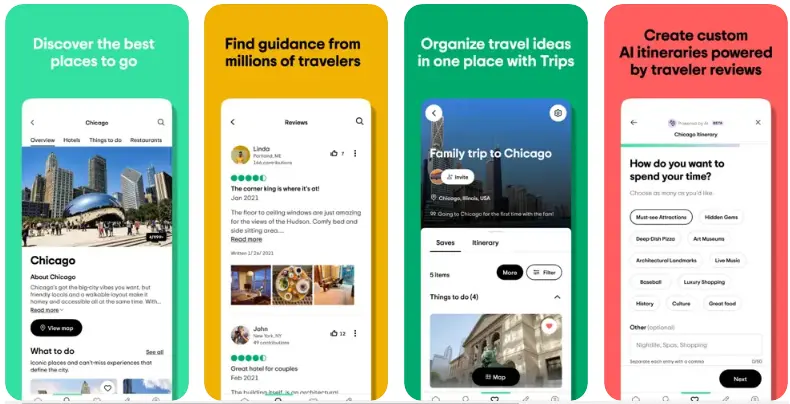
TripAdvisor has become the world’s largest travel guidance platform, assisting millions of people to travel on their trips without hiring any personal agent for the same.
The team always believes in equity, diversity, and inclusion, assisting the people to find a suitable place to visit according to their budget.
4] Kayak
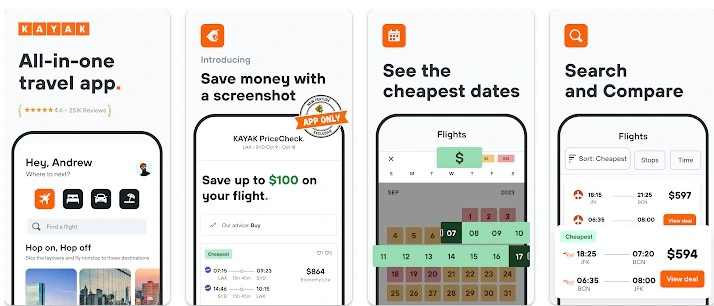
Kayak is a travel app helpful for covering hotel stays, rental cars, train and bus tickets along travel experiences. To create an app like Kayak, all you need is to have the right guidance.
The app helps search for different travel sites and represents all available options, it also assists in picking what works best for the users.
5] Booking.com
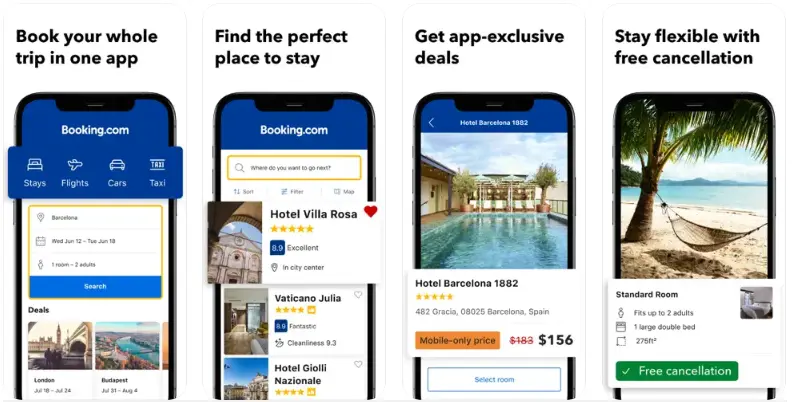
Booking.com is a site for booking flights, car rentals, airport taxis, attractions, and tours. This can be one of the best apps helpful for you to find a great hotel.
To develop an app like Booking.com, you can check its amazing features such as the availability to book in 43 languages, which offers more than 28 million accommodations that include over 6.6 million homes and apartments.
6] Expedia
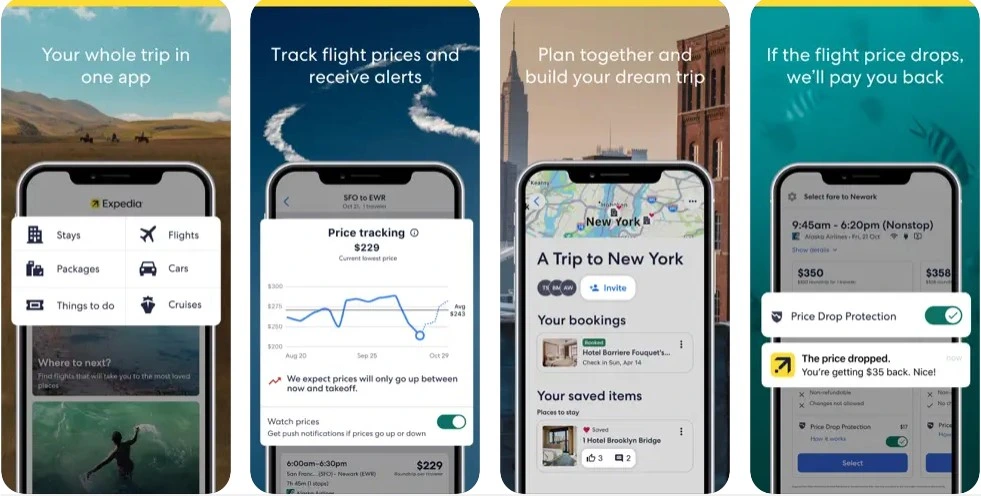
Expedia is an online agency which is owned by the Expedia group, which is based in Seattle. Its app and website are used to book hotels, airline tickets, car rentals, cruise ships, and vacation packages.
It is an American travel technology company that owns and operates travel fare aggregators, along with travel metasearch engines.
These are all the best apps you can undertake to get inspired to build your next dream travel software.
The Process to Develop a Travel App: Step-By-Step Guide
Developing a travel app is a complex undertaking that demands meticulous planning, technical proficiency, and a keen eye for detail.
Every stage of the development process is pivotal in guaranteeing that your platform is secure, user-friendly, and capable of meeting the demands of your users.
Let’s delve into the intricacies of this journey:
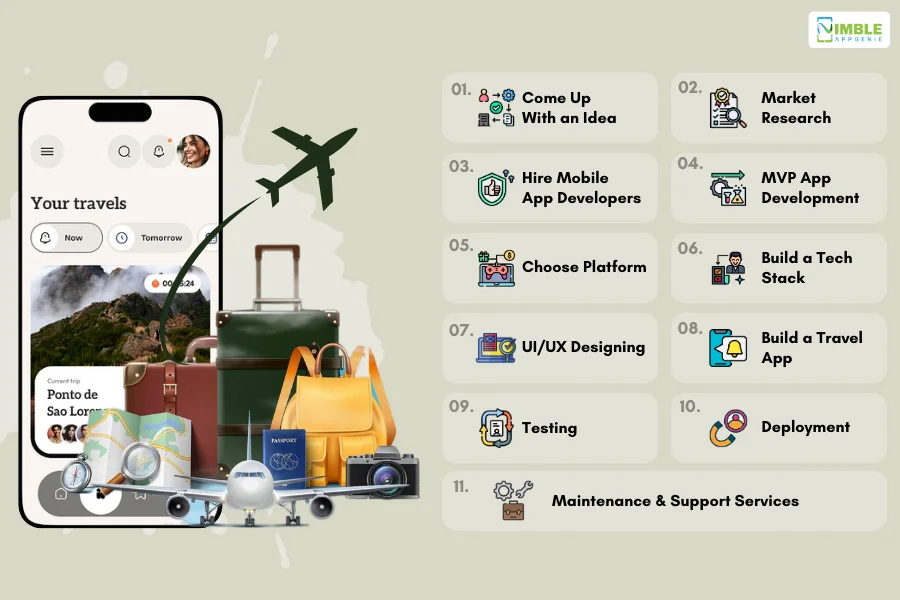
Step 1: Come Up With an Idea
The first step of building a travel app is to come up with an app idea.
It is recommended that you work with more than one idea. The reason is that if one of your ideas doesn’t work out, you have a backup plan.
It’s important to identify a unique and valuable idea that addresses a specific need or pain point in the travel industry. You should also consider the target audience, their preferences, and existing gaps in the market.
Step 2: Market Research
After ideation, it’s time to conduct mobile app market research.
This is the part where you find competitors, market analysis, market openings, and so on.
It is the process where you study consumer behavior, market trends, competitor activities, etc. to make informed business decisions. This will help you in making effective marketing strategies that can drive growth and make your business a profitable venture.
Some of the highlights under market research include-
- Target Market Research: It comprises Identifying and getting to know your target market; those people who are an optimal fit for what you have to offer. This includes demographics, psychographics (attitudes), behaviors, etc.
- Competitor Analysis: Determining the weaknesses and strengths of your competitors, as well as their market position.
- Industry Analysis: Overall size of the market, growth potential, and key trends in your industry.
- Consumer Research: Collecting information about consumer attitudes, preferences, and purchasing behavior through surveys of the population or interviews with a random sample.
By determining your target customer base, market research can give you the much-needed knowledge of potential risks and opportunities in addition to providing a way to overcome them.
Once you are done with this, we have to hire app developers.
Step 3: Hire Mobile App Developers
Here are a few things to keep in mind:
- Problem-Solving Skills
- Learning Agility
- Passion for Technology
- Attention to Detail
- Ability to Work Under Pressure
- Cost to hire
- Location of developers
Once you have the developers by your side, here’s what we are going to do.
Step 4: Creating an MVP App
Building an MVP app is the key step to creating a successful travel app. But why do we make an MVP before we develop a travel app?
MVP is a bare-bones version of the app that allows you to visualize the idea, its features, and its design. Moreover, it also helps you gather valuable user feedback.
An MVP is a very valuable way to test whether your app idea works, and more importantly — what it lacks. Focus on the basics and release an MVP of your travel app to reduce risk, speed up the development process & increase chances of success.
Step 5: Choose Platform
With all that said and done, it’s time to choose a platform.
You can either go with an Android app or an iOS app in the native category. On the other hand, you can also choose to develop a Hybrid app.
Selecting a platform is one of those choices that can have a huge effect on the effectiveness and range you implement, be it for travel or business applications.
In the end, your goals will drive how effective your platform is in performing tasks and whether you are happy at least a few years down the road after it has been live for a while. So, the right decision-making is important to have satisfactory results while best catering to the user experience as well.
Once this is done, it’s time to build a tech stack.
Step 6: Build a Tech Stack
Tech stack refers to the technologies used to create the travel app. This includes everything, starting from programming languages to frameworks.
It can highly affect the overall performance of the app; therefore, it’s something that you should pay special attention to.
You have to get the right components that you will use based on how well they perform tasks such as real-time bookings, data processing, and user interactions.
For example, ensuring the app was built with a right backend framework that could scale to handle large volumes of data/transactions is important (travel apps have billions of user bookings at any given moment).
To summarize, a travel app with the right tech stack ensures its reliability to handle large volumes of user data and scalability along with enabling higher quality consumer experience which is the key to their success and adoption.
Step 7: UI/UX Designing
The UI/UX design process is an integral part of building a travel app. It helps to create a visually appealing, user-friendly, and interactive app that provides an excellent user experience.
To create a travel app successfully, UI/UX designing is a crucial component that essentially defines how users will engage with the application. UI is the look and feel — how your app visually presents itself, e.g., colors and fonts for clarity of content on a screen.
Good UI designs are perfect if you manage to create simple, easy-to-use, and visually appealing screens which can also result in more user interactions. This means creating UIs that make it easy for users to search and book flights, rent hotels, and view itineraries in a travel app.
Contrarily, the UX (User Experience) design focuses on how easy and enjoyable a product is to use and what kind of overall experience it provides from start to finish.
Good UI/UX design together ensures that a travel app is not only visually beautiful but user-friendly and efficient too, which results in higher retention of users, feedback quite happy from them, and increased usage.
This will be pivotal in setting your app apart in a crowded marketplace and helping it last beyond the initial honeymoon period.
Step 8: Build a Travel App
This is the part where dedicated developers write the travel app source code and create the final version of the app. This step is highly resource-intensive.
The process involves several key stages, each critical to ensuring the app meets user needs and business goals. Initially, defining the app’s purpose and features is essential.
The development phase involves coding, integrating necessary APIs (like payment gateways and location services) and ensuring robust performance and security.
Therefore, it’s highly recommended that you maintain good communication with the development side.
Step 9: Testing
Once the app is developed, it’s time for app testing. And that’s exactly what happens in this process.
QA team works on identifying and fixing bugs, technical issues, and errors to ensure that your app provides an amazing experience.
This phase involves systematically evaluating the app to identify and resolve issues that could impact usability, performance, or security. Thorough testing covers various aspects, including functional testing to verify that all features—such as booking systems, payment gateways, and real-time updates—work as intended.
By identifying and addressing potential issues early, testing helps deliver a polished, reliable, and user-friendly app, ultimately contributing to its success and positive reception in the competitive travel app market.
After the app is tested, it’s time to deploy it.
Step 10: Deployment
Depending on the platform, the deployment process can be a little different. But in any case, the app will be approved within 2 weeks.
In addition to deployment, app developers must navigate the submission process successfully and meet compliance standards when submitting apps to marketplaces like the Apple App Store and Google Play Store, while addressing reviewer feedback during review.
Making sure that getting your app deployed translates into a stable, secure, and available product for your users creates the baseline for launch success as well as continuous post-launch user engagement. This makes for quicker updates and the opportunity to enhance its performance based on user feedback or metrics.
Till then, you can make marketing strategies to increase the downloads of your travel app.
Step 11: Maintenance & Support Services
Now, once the app is deployed the next step is maintenance & support services.
This is where you should work on user feedback, release new updates, apply security patches, and roll out new features based on user feedback.
Ongoing maintenance ensures that your platform is functional and stays up to market requirements.
This is the entire process of building a travel app. But you must be wondering what the total cost is. Let’s answer these questions:
What’s the Cost to Create a Travel App?
So, ‘’How much is the cost to build a Travel app?”
Well, on average, the cost to develop a travel app ranges from $20,000 to $150,000 for a basic app based on different factors including the location of the development team, complexity of your project, features, and more.
To understand it better, here is a quick breakdown of the cost of building a travel app:
| Features/Components | Low-End Cost (USD) | High-End Cost (USD) |
| App Design and Development | 10,000 | 100,000 |
| UI/UX Design | 2,500 | 15,000 |
| Front-end Development (iOS/Android) | 3,500 | 35,000 |
| Back-end Development (API, Database) | 4,000 | 50,000 |
| App Features | 5,000 | 30,000 |
| User Registration and Login | 1,000 | 5,000 |
| Search and Filtering | 1,000 | 5,000 |
| Booking and Payment Integration | 2,000 | 10,000 |
| Recommendations and Personalization | 1,000 | 5,000 |
| Push Notifications and Alerts | 1,000 | 5,000 |
| App Testing and Quality Assurance | 3,000 | 10,000 |
| Manual Testing | 1,500 | 3,000 |
| Automated Testing | 1,500 | 7,000 |
| App Deployment and Maintenance | 2,000 | 10,000 |
| App Store Submission | 500 | 2,000 |
| Ongoing Maintenance and Updates | 1,500 | 8,000 |
| Total | 20,000 | 150,000 |
Note: This is just an estimate, to get the right cost, make sure to connect with a mobile app development company with all your project requirements.
How Do Travel Apps Make Money?
After considering the cost to invest while building a travel app, it is essential to identify diversified patterns for earning money.
Here is a list of travel app monetization frameworks to consider.
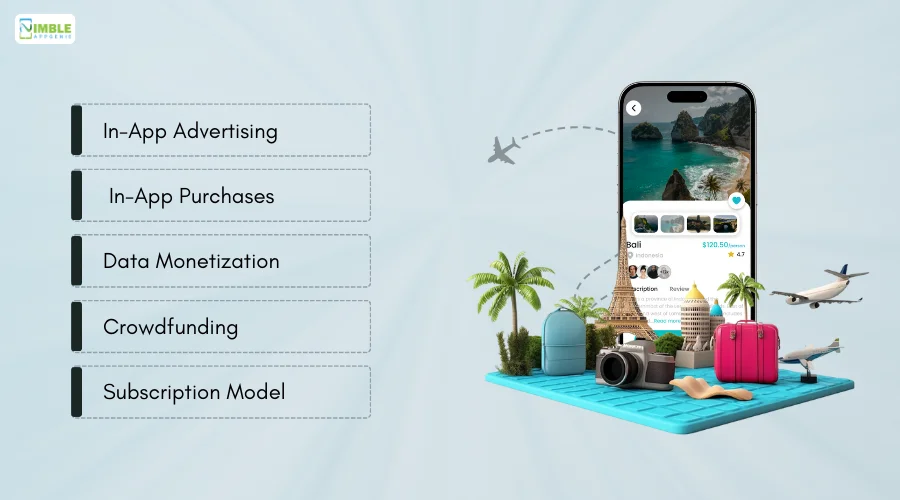
➤ In-App Advertising
It is a significant revenue stream for travel apps, especially those with a large user base. Here you can earn money by lending a space to the brands to advertise their products and services. In-app advertising is all about the display of paid ads.
➤ In-App Purchases
Within the app, adding new features to attract users and then fixing a price to avail them is a monetization strategy that can be adopted for travel apps. This strategy offers a low barrier to entry for the users and assists you in having a permanent source of income.
➤ Data Monetization
Data monetization comprises utilizing the user’s data to earn money. Here all you need is to get consent from the users and then use their data to make reports helpful for other brands to access the crucial information.
➤ Crowdfunding
Crowdfunding is an important monetization strategy that is based on the trust between the app’s owner and users of the app. This strategy is effective when your business is at the initial stage. Here you can raise funds by inviting people to contribute to it.
➤ Subscription Model
For a travel app, the subscription model is suitable where you can set different prices based on the user’s interest. This strategy can become a permanent source of income for your dream travel app.
These are the travel app monetization models, to know more, you can connect with an experienced group of developers.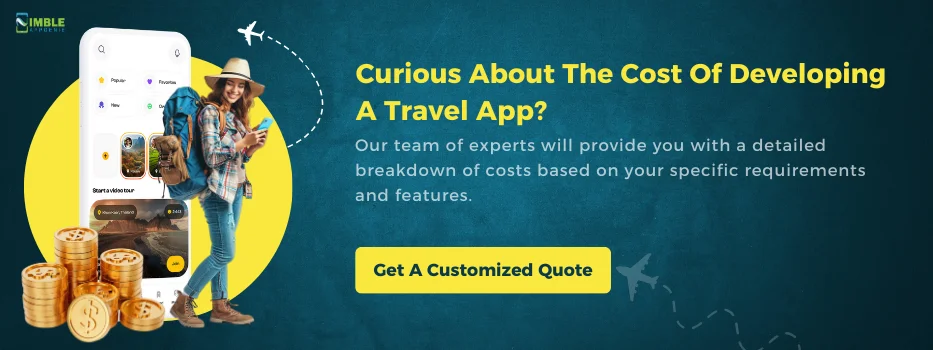
How Can Nimble AppGenie Help You to Develop a Travel App?
Looking at the travel industry, it is clear that the industry is experiencing extraordinary growth, fueled by a surge in leisure travel, business trips, and the increasing popularity of adventure tourism.
With the rise of digital nomads and remote work, travelers are seeking more flexible and personalized experiences, creating a significant demand for innovative travel apps that can cater to diverse needs.
This is your opportunity to build a travel app by partnering with the best travel app development company i.e. Nimble AppGenie to bring your innovative travel app idea to life.
Our team of experienced developers and designers specializes in creating cutting-edge travel solutions that cater to the evolving needs of modern travelers.
If you have an idea and we are here to convert it into a successful solution, Contact us.
Conclusion
Crafting a thriving travel app necessitates a meticulously crafted plan, a deep-rooted focus on user needs, and the expertise of seasoned developers.
By following the guidelines provided in this comprehensive guide, you can significantly elevate your prospects of developing a travel app that resonates with travelers and generates substantial revenue for your enterprise.
FAQs

Niketan Sharma is the CTO of Nimble AppGenie, a prominent website and mobile app development company in the USA that is delivering excellence with a commitment to boosting business growth & maximizing customer satisfaction. He is a highly motivated individual who helps SMEs and startups grow in this dynamic market with the latest technology and innovation.
Table of Contents




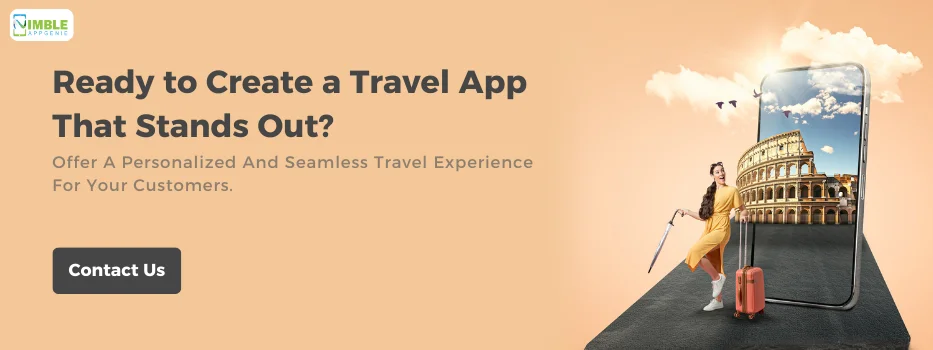
No Comments
Comments are closed.